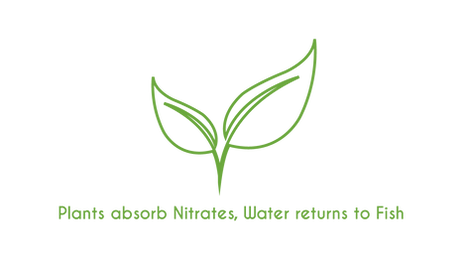
WHAT IS AQUAPONICS?
AN ECOSYSTEM
Aquaponics is the agricultural practice of growing plants and fish in a closed, recirculating ecosystem.
Within a closed system, aquaponics recycles water which, by many estimates, reduces water consumption by 90 percent to 99 percent. The majority of the water in the aquaponics system is directly used by the plants, resulting in higher efficiency. More water is used in traditional agriculture because very little of it goes straight to the plants. Much of the water is lost to runoff, evaporation, and soil absorption.


A METHODOLOGY
Aquaponics is a combination of both hydroponic and aquaculture methods.
This is the simplest approach to categorizing aquaponics, but as you'll see, aquaponics is distinct from both hydroponics and aquaculture. Like hydroponics, aquaponic agriculture grows plants without the use of soil. This is possible because soil is not a necessary component for growing plants. In traditional, soil-based agriculture the soil acts as a reservoir for the nutrients required by plants to grow. In hydroponics, the plants pull nutrients directly from the water.
However, most water supplies contain minimal nutrients. Hydroponic agriculture often requires nutrients to be added to the water by using organic or chemical solutions. Typically, this chemical-rich water cannot be re-used after it has been cycled through a hydroponic system, and in many cases, is actually considered toxic to humans and animals. In this case, the water should not be re-introduced to the environment. Admittedly, not all hydroponic production results in toxic water, and the hydroponic industry has improved over the years. Producers now have safer, more effective options to raise produce. Not every producer (whether hydroponic or traditional agriculture) unfortunately has embraced environmentally-friendly practices.
Aquaculture is a farming method used to raise aquatic species. This is done in a controlled water environment, such as large tanks, confined pools and segregated portions in natural bodies of water. A variety of aquatic creatures like fish, mollusks, crustaceans and plants may be raised and harvested in these environments. However, the practice of aquaculture can cause an array of damage to the natural environment. High-density populations of fish result in high-density waste, which must be managed through cleaning, mitigation or removal. In natural bodies of water, waste accumulation can upset the delicate balance of the aquatic ecosystem. In the worst case scenario, the waste is not removed and the water becomes toxic to the fish resulting in the death of most or all the fish. Additionally, there is ample concern about the introduction of invasive, non-native species into nature.
Both hydroponics and aquaculture on their own have challenges and require additional inputs for a single product. Hydroponics requires added nutrients and often results in an unwanted output (toxic water). While in aquaculture, the burden of managing fish waste is tremendous, not to mention managing other potential environmental risks. There is a single product in both methods, either a plant or a protein. Aquaponic agriculture combines the best of both worlds by leaving behind the unwanted parts. Aquaponic systems cycle the fish waste in the water is cycled into grow beds where seeds or plants are growing. This fish wastewater provides the essential nutrients for plant growth and reduces the need for added chemical nutrients. In turn, the plants essentially clean the waste from the water and return it back to the system where it is reused and recycled efficiently.

A MICROBIOLOGICAL PROCESS
Aquaponics relies upon microbiological processes to foster the relationship between plants and fish.
While the above information provides a general picture, there is actually a lot of science behind the relationship between the fish and plants thriving together. A brief explanation is as follows; however, for a more technical discussion, we recommend you check out this peer-reviewed article. Ammonia is released by the fish waste. While high levels of ammonia would normally kill fish in an aquaponic system, this ammonia is converted into nitrites and then into nitrates by naturally occurring bacteria that develop in the aquaponic system. Remember, not all bacteria is bad. The bacteria that occur naturally in this system are good bacteria and are necessary for a thriving aquaponic system, much like many of the bacteria humans carry on their body are good bacteria that actually keep us healthy. Plants then absorb the nitrates that result from this conversion process, providing all the necessary nutrients for the plant to grow. The result of this natural process is clean water that provides a safe environment for the fish. Check out our graphic below.




A couple important things to know about the aquaponic cycle:
1) The bacteria in an aquaponic system take time to grow and develop. How long it takes depends on the design of your specific system, the size of the system, water cycling strategies and fish species. There are methods to assess the required time for bacteria development in your system, and we recommend that any aquaponics farmer plan for at least one month for the system to reach readiness before planting any valuable crops or using costly fish.
2) The aquaponics cycle is on-going. For lack of a better word, it’s a batch at a time. It’s a constant process that is naturally occurring at all times in the system. The water requires some basic monitoring to ensure that there is a healthy level. This can be done through water testing (which is recommended) as well as experience. A seasoned aquaponics farmer will be able to look at crops and know if the water requires some adjustment. However, until you reach that point and are comfortable with the inherent risks (like fish kills and loss of crops), we recommend regular water testing.
